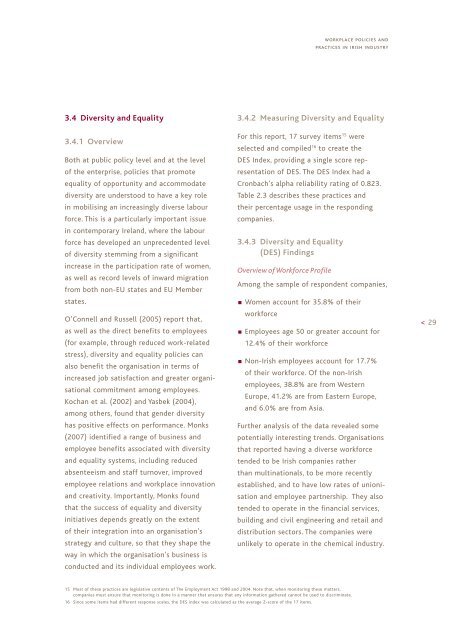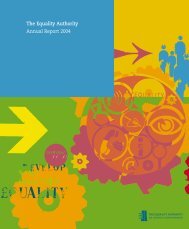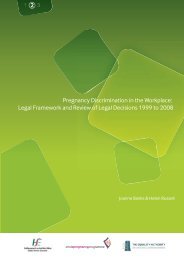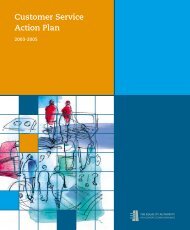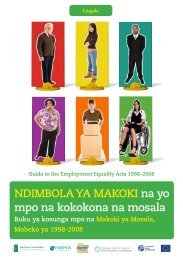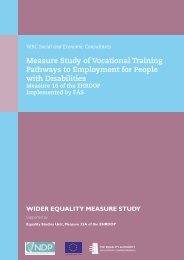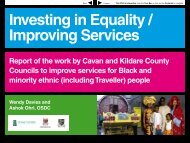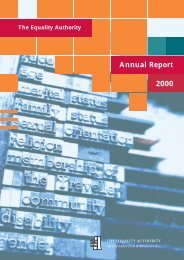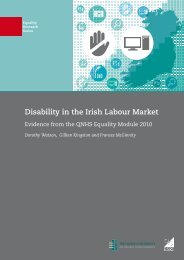New Models of High Performance Work Systems - Equality Authority
New Models of High Performance Work Systems - Equality Authority
New Models of High Performance Work Systems - Equality Authority
- No tags were found...
Create successful ePaper yourself
Turn your PDF publications into a flip-book with our unique Google optimized e-Paper software.
workplace policies andpractices in irish industry3.4 Diversity and <strong>Equality</strong>3.4.1 OverviewBoth at public policy level and at the level<strong>of</strong> the enterprise, policies that promoteequality <strong>of</strong> opportunity and accommodatediversity are understood to have a key rolein mobilising an increasingly diverse labourforce. This is a particularly important issuein contemporary Ireland, where the labourforce has developed an unprecedented level<strong>of</strong> diversity stemming from a significantincrease in the participation rate <strong>of</strong> women,as well as record levels <strong>of</strong> inward migrationfrom both non-EU states and EU Memberstates.O’Connell and Russell (2005) report that,as well as the direct benefits to employees(for example, through reduced work-relatedstress), diversity and equality policies canalso benefit the organisation in terms <strong>of</strong>increased job satisfaction and greater organisationalcommitment among employees.Kochan et al. (2002) and Yasbek (2004),among others, found that gender diversityhas positive effects on performance. Monks(2007) identified a range <strong>of</strong> business andemployee benefits associated with diversityand equality systems, including reducedabsenteeism and staff turnover, improvedemployee relations and workplace innovationand creativity. Importantly, Monks foundthat the success <strong>of</strong> equality and diversityinitiatives depends greatly on the extent<strong>of</strong> their integration into an organisation’sstrategy and culture, so that they shape theway in which the organisation’s business isconducted and its individual employees work.3.4.2 Measuring Diversity and <strong>Equality</strong>For this report, 17 survey items 15 wereselected and compiled 16 to create theDES Index, providing a single score representation<strong>of</strong> DES. The DES Index had aCronbach’s alpha reliability rating <strong>of</strong> 0.823.Table 2.3 describes these practices andtheir percentage usage in the respondingcompanies.3.4.3 Diversity and <strong>Equality</strong>(DES) FindingsOverview <strong>of</strong> <strong>Work</strong>force Pr<strong>of</strong>ileAmong the sample <strong>of</strong> respondent companies,p Women account for 35.8% <strong>of</strong> theirworkforcep Employees age 50 or greater account for12.4% <strong>of</strong> their workforcep Non-Irish employees account for 17.7%<strong>of</strong> their workforce. Of the non-Irishemployees, 38.8% are from WesternEurope, 41.2% are from Eastern Europe,and 6.0% are from Asia.Further analysis <strong>of</strong> the data revealed somepotentially interesting trends. Organisationsthat reported having a diverse workforcetended to be Irish companies ratherthan multinationals, to be more recentlyestablished, and to have low rates <strong>of</strong> unionisationand employee partnership. They alsotended to operate in the financial services,building and civil engineering and retail anddistribution sectors. The companies wereunlikely to operate in the chemical industry.< 2915 Most <strong>of</strong> these practices are legislative contents <strong>of</strong> The Employment Act 1998 and 2004. Note that, when monitoring these matters,companies must ensure that monitoring is done in a manner that ensures that any information gathered cannot be used to discriminate.16 Since some items had different response scales, the DES index was calculated as the average Z-score <strong>of</strong> the 17 items.


